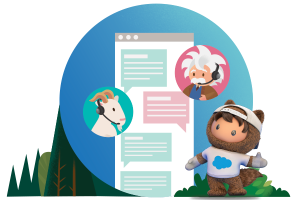The Fourth Industrial Revolution is well underway: technological innovation is continually redefining customer expectations, and businesses are trying to keep up. According to Salesforce’s third edition of the State of Service report, 82% of customer service decision-makers think their customer service must transform to stay competitive. But what shape will this transformation take? And what can businesses do to get ahead of the game?
One key trend highlighted in the report is that customers now expect to have access to immediate customer support across all channels. Salesforce’s State of the Connected Consumer report found that in the UK, 69% of consumers want to talk with a company in real-time, and 60% expect this experience to be connected. That means, for example, if a client messages support on Facebook Messenger, Customer Service teams should have this knowledge when the client calls support over the phone.
This means that an omnichannel approach to customer service is crucial for businesses to meet customer expectations. One key component of any omnichannel approach is live chat software. Online chat software enables support agents to talk to clients in real-time, solving any problem that may arise either in using the product or while making a purchase, while also enabling agents to handle multiple queries at once.
Here are six powerful reasons why we think live chat software is crucial to your business:
1. Live chat software is customers’ preferred support channel
A recent Salesforce study found that in the UK, 41% of consumers state that live chat is their preferred channel of support. Whether it’s used as a customer service tool or as part of the sales journey, live chat tools can give customers real-time interaction. There are three main benefits:
- For many customers, online chat software is more convenient and less stressful than speaking on the phone to a stranger.
- It’s easier to interrupt a session and return with the document or reference they need, and they can be sure they’ll be understood.
- Moreover, most customer service chat software includes the ability to voice call, screen share or send screenshots. This makes it an incredibly effective tool for resolving support issues.
2. Online chat software offers a connected customer experience
Innovative companies are understanding the paradigm shift from a segmented to a connected customer experience. Customising the customer service experience is an integral part of adapting to users’ specific requirements.
Cochlear is the global leader in implantable hearing aid solutions and they faced a major challenge: providing seamless customer support to a community with a range of hearing impairments.
As a tech innovator, they understood how crucial user preferences are and live chat has become a key part of their overall customer experience. The steep learning curve involved in adapting to a Cochlear implant can present its own challenges, especially if a user is still struggling to differentiate sounds. According to Kate Obermeyer, Cochlear recipient and employee, “voice calls are not necessarily your first choice”.
3. Live chat software increases first contact resolution
There’ll always be some interactions that are best handled on the phone. But many simple queries can be resolved by a combination of live chat and an online knowledge base, leaving your expert call centre agents free to deal with large, complex support tickets. Customer service chat software excels at dealing with relatively simple queries that can be resolved quickly.
After introducing Service Cloud, leading UK cleaning brand Vax increased first contact resolution from 78% to 87%, while at the same time reducing phone contact from 81% to 76.5%. This freed up phone agents for increasingly complex queries and up-sell/cross-sell opportunities. Live chat was integral to this effort and impressively, 91% of their customers who engaged via live chat said they found it useful and would do it again.
What’s more, live chat provides you with excellent tools for analysing and improving the customer support experience including:
- Transcripts of every interaction – which you search by keyword, theme, customer type, sales channel, support ticket outcome.
- Feeding customer data into your business CRM allows a 360-degree view of your customers.
- Common support questions help you pinpoint gaps or navigational problems in your online support content.
- This data allows you to create new content around these questions and further encourages self-service.
4. Online chat software builds trust
By having live chat tools on your website and making it available as a support option, you’re helping to build trust. Different people prefer different contact channels, and by presenting a wider range of options, customers will feel that you’re more responsive, more available and generally more interested in what they want.
Live chat also gives you the option of longer service hours, covering evenings and weekends when call centres may be closed. Again, fitting your customer service offering around your customers’ lives can only be a good thing.
To really earn your customers’ trust with live chat you need to choose your agents carefully. Use experienced customer service people, but remember that live chat requires a slightly different mix of skills to call centre work – accurate keyboard skills and a clear, concise writing style are the on-screen equivalents of clear diction and a friendly voice.
5. Live chat software can drive sales as well as service
Although traditionally considered a piece of help desk software, there’s no reason to limit live chat to customer support. The positive response that customers have to live chat means it can be an effective sales tool too, especially when it comes to reducing dropouts during the purchase process.
This was an unexpected benefit with Vax – as we saw above, this UK cleaning brand was able to increase first contact resolution, freeing up more time for upselling. This increased Vax’s year-on-year e-commerce sales by 26%.
The great advantage of live chat is that you can target it very precisely:
- Is there a particularly high drop-out rate at a certain point in the sales journey? A live chat agent could help people through that stage of the process.
- Do your web analytics show customers making repeated visits to a page without buying? Live chat can be targeted specifically at those customers, offering help, answering questions and handling objections at just the right moment.
In short – if your business would benefit from a more efficient, more intelligent and more responsive customer service channel, you should be considering live chat for your website.
6. Live chat software vs. AI Chatbots
A study which surveyed UK SME business leaders found that 33% considered keeping up with customer expectations as a major problem. One cost-effective way of staying ahead of customer expectations is AI chatbots. But what exactly is an AI chatbot and how are they different from live chat software?
An AI chatbot is an automated chat agent that can harness machine learning and natural language processing to automate certain responses. This could be checking an order or providing a customer with a copy of a sales receipt. Chatbots are transforming customer service in many industry sectors, particularly in customer service and sales.
Clearly, businesses understand the benefits of this emerging technology, as another study found that 53% of service organisations expect to use chatbots within 18 months — a 136% growth rate that foreshadows a big role for the technology in the near future.
Furthermore, research shows that high-performing service organisations are around 2.1 times more likely to be using AI chatbots than underperformers. This study also revealed that 64% of agents with AI chatbots are able to spend their time solving complex problems, versus 50% of agents without AI chatbots. Clearly, AI chatbots are becoming a crucial part of high-functioning teams.
Harness the power of live chat software today
So what are you waiting for? Start harnessing the powerful benefits of live chat software today to help meet and exceed customer expectations in both service and sales.
Check out the third edition of the State of Service Report for key industry insights on all the latest trends in customer service.

























